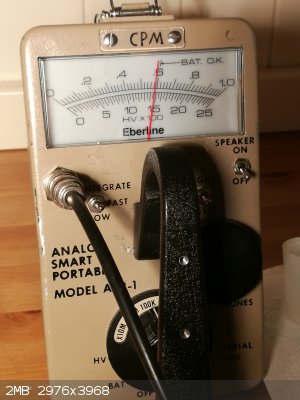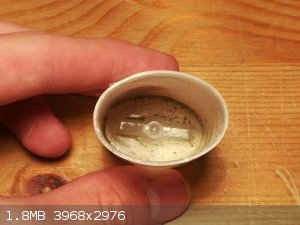
RadiumQuetzal - 13-8-2020 at 14:11
Hi
I have tried to make radium paint that glows like it used to for quite some time now with decent success. While it does generate some luminescence it
is too faint for my liking so I wonder, does anyone know a good method to make paint that glows quite well?
My method
1. Mixed new ZnS:Cu with acetone to remove any kind if adhesive that might cause it to glow less. (Seems to make it work a bit better even tho the
ZnS:Cu is brand new)
2. Dissolved around 0.5ug of RaBr2 and mixed it in with the ZnS:Cu
3. Mixed it around over and over again until all the water had dried.
I of course left it in a dark space for 24h before checking if there were any luminescence from the paint. (checked in total darkness during a span of
10min)
Left pic is a measurement of the paint. Detector used is an Eberline ASP-1 with a Ludlum 44-9 probe. Right pic is the paint.


[Edited on 13-8-2020 by RadiumQuetzal]
Cezium - 17-8-2020 at 01:16
No sure if 10kBq of Ra is enough to glow... Maybe with some really good phosphor.
RadiumQuetzal - 17-8-2020 at 13:51
I thought so too but then I realized that some of the clocks with radium contains even less and still used to glow. One of those containing a total of
0.0259ug of Ra-226 and the paint should be ZnS:Cu due to it's age.
Ubya - 17-8-2020 at 17:39
maybe the particle size is smaller? with bigger particles of ZnS only the outside is in contact with the radium salt, i don't know how much the
radiation would penetrate inside the particle, or if that internal glow would even be visible to our eye, but in general the finer and more intimate
the mixture the better should be the result.
RadiumQuetzal - 18-8-2020 at 02:20
Hmmm dont think that the particle size should be an issue. The ZnS:Cu I used should be the same type used in clocks. It was sold as clock/watch paint
and it seems like really fine powder.
Cezium - 30-8-2020 at 13:15
Maybe try with UV light if it even glows at all, ZnS:Cu is quite sensitive to contaminants.
RadiumQuetzal - 31-8-2020 at 11:07
It does glow and I have gotten it to glow on it's own to some extent mixing with radium. The luminescence is just too low.
I have a new idea which I'm currently testing.
Clean the paint using chloroform or acetone.
Dissolve the old ZnS in hcl where it is then dried leaving radium and zink chloride.
Then add acetone and the new ZnS, mixing as often as possible.
FragranceLover89 - 31-10-2020 at 17:16
Have you tried strontium aluminate instead of ZnS?
p4rtridg3 - 5-11-2020 at 17:39
AFAIK an important part of the manufacture of Radium dials was getting the ZnS crystal size and shape right. They had some specialized processes for
it, but I don't know any details.
Maybe try with one of those kits that supposedly restores the glow in radium watch hands. They can be found on eBay. I believe most just contained the
specially made ZnS that could be reapplied after the alpha radiation damaged the original phosphor too much.
Crazy_Chemist - 9-3-2022 at 07:21
Hi!
I've thougt to do the same, I have bougt some radiumpainted watch-hands om eBay, and I want to solve the radium in some milliliter, but which solvent
should I use? Is it more efficient to scrape off the radium from the clock hand? Or maybe it can be dangerous? I know about the radium girls.
Then I want to add a suitable substance so that will shines again and had thought zinc sulphide, or is there something more effective? And how much is
it on a clock hand, but of course it depends on the size. Somewhere I read 1 µg, is that correct? It shows about 60,000 Bq on a hand.
Thanks for all the tips!
And I wonder what salt it is in the paint? RaSO4 is said to be completely insoluble in water.
Crazy_Chemist - 12-3-2022 at 23:34
I ordered two types of zinc sulfide yesterday:
Zinc sulfide: Copper doped https://onyxmet.com/index.php?route=product/product&prod...
Zinc sulfide: Silver doped https://onyxmet.com/index.php?route=product/product&prod...
I expect that the copper doped gives a more green light, and the silver doped a more blue light? So lets say I want do make both. I also bought
this...

So how to easy scrape of the radium from all the hands and solve it, maybe wash it too. I don't want to spill aroud the radium or get it in me, so I
will make it in a sealed workspace. The average clock hand contains about 1 µg radium, so I maybe get 50 µg radium.
Then, what solve it in? Maybe it's not had to be solved? Maybe it's enough to mix it up? Then I split it in to two miniature cans, one green and one
blue. How much ZnS do I need in each can to get efficient exchange?
unionised - 13-3-2022 at 03:52
I'm pretty sure that ZnS isn't stable in air and will oxidise to ZnSO4 (with accompanying hydrolysis, and carbonate formation etc).
Even if that's only a surface effect you will still have a problem because the alphas don't penetrate far.
Crazy_Chemist - 11-4-2022 at 01:47
But how should I solve the zinc sulfide, so I can paint it om the clock hands? It's insolutable in water...
unionised - 11-4-2022 at 01:50
You don't dissolve it.
You make a suspension of it.
JGHFunRun - 12-9-2022 at 19:56
Yea I don't work with radiation but most paints exist as suspensions. Prussian blue is insoluble in basically everything but it's easy to make a
colloidal form that you can then use with whatever your favorite paint base is. If you don't know how to do that you can look into mixing paint, it's
something a lot of artists do when they really want to make the paint their own so there's a decent chunk of information on it
[Edited on 13-9-2022 by JGHFunRun]
JGHFunRun - 14-9-2022 at 12:26
Oh and also I hope you know what you're doing, the Styopyro Discord server has had many incidents where people going in the reverse direction (radium
from watches) end up having to be decontaminated by the feds. Currently the #science-general chat is discussing the aftermath of someone doing exactly
that
[Edited on 14-9-2022 by JGHFunRun]

